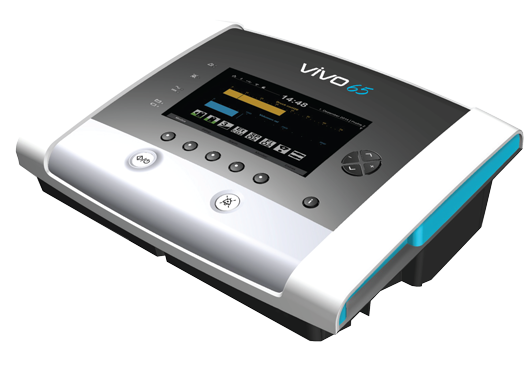Indicated for pediatric (from 11 lbs / 5 kg) and adult patients, the Vivo 65 effectively treats a broad range of respiratory diseases while providing ease of use to medical staff and care givers.
Intended Use:
To provide continuous or intermittent ventilatory support for the care of individuals who require mechanical ventilation.
Indications for Use:
The Vivo 65 ventilator (with or without the SpO2 and CO2 sensor) is intended to provide continuous or intermittent ventilatory support for the care of individuals who require mechanical ventilation. Specifically, the ventilator is applicable for pediatric through adult patients weighing more than 5 kg (11 lbs.)
The Vivo 65 with the SpO2 sensor is intended to measure functional oxygen saturation of arterial hemoglobin (%SpO2) and pulse rate.
The Vivo 65 with the CO2 sensor is intended to measure CO2 in the inspiratory and expiratory gas.
The device is intended to be used in home, institution, hospitals and portable applications such as wheelchairs and gurneys. It may be used for both invasive and non-invasive ventilation. The Vivo 65 is not intended to be used as a transport or critical care ventilator.
It is currently only available in the United States.
The Vivo 65 USA is the latest ventilator of Breas Medical for use in the hospital, post-acute care institutions and the home. Vivo 65 has been developed with the needs of professional caregivers and patients in mind: to provide highly effective and comfortable treatment and to help avoid readmissions to the hospital.
Vivo 65 is an ideal choice for treatment of children (> 11 lbs / 5 kg) thanks to its accurate volume delivery and highly responsive trigger system. With its intuitive user interface, the Vivo 65 is easy-to-use and easy-to-teach.
PC Software
PC Software Introduction
PC Software Download Function
PC Software Analyze Patient Data
PC Software Remote Learning
- Clinical Excellence
• Excellent trigger and highly accurate volume measurement technology
• Extensive set of modes, including Pressure and Volume Modes, SIMV
• A variety of patient circuits: Single limb with leakage or exhalation valve and dual limb for measurement of exhaled volume
• Extensive alarms
• Three profiles to quickly adjust the settings to the needs of the patient
• Simple menu structure
• i-Button for guidance and explanations - Connectivity to PC software
• PC software allow monitoring of up to 10 Vivo 65 ventilators simultaneously
• Real-time monitoring and clear indication of alarms
• Waveforms and loops for in-depth analysis of treatment
• 365-day storage of data
• Facilitates workflows and timely intervention - Extensive Monitoring
• Integrated monitoring of SpO2, FiO2 and CO2 helps reduce the need for external monitoring devices and reduce cost.
• Numerical values and waveforms on the screen, multiple alarms
• CO2 monitoring is quick and easy to use, does not require calibration and provides increased insight into the quality of ventilation.
The Vivo 65 brings advanced monitoring capabilities providing detailed insight in the quality of ventilation.
- Integrated monitoring of SpO2, CO2 and FiO2
- Real time values and curves on the device
- Comprehensive alarms
- PC software for detailed analysis and reporting
- 12 hour autonomy with the 4 hour internal battery plus the 8 hour click-on battery
Adaptable to patients’ needs and prescriber preferences
- Suitable for a wide range of pathologies and for patients with changing requirements over time
- Multiple circuits: dual limb with exhaled volume measurements, single limb with exhalation valve or leakage port
- Invasive and non-invasive ventilation
- Multiple modes – Pressure and Volume Modes with Target Volume and SIMV
Easy-to-use thanks to intuitive user interface
- Simple menu structure
- User friendly color interface
- Easy to teach, easy to learn, reducing risk for mistakes
- Extensive analysis and detailed reports in the PC software
Settings / Performance
Ventilation Modes
PSV, PSV(TgV), PCV, PCV(A), PCV(TgV), PCV(A+TgV), VCV, VCV(A), PCV-SIMV, VCV-SIMV, CPAP
Patient Modes: Adult, Pediatric
Device Modes: Home, Clinical
Inspiratory Pressure: 4 to 50 cm H2O
PEEP: Off, 2 cm H2O to 20 cm H2O for Adult / 20 cm H2O Pediatric
Tidal Volume: 50 — 2000 ml
Target Volume: 50 — 2000 ml
Breath Rate: 4 — 60 bpm
SIMV Rate: 4 to 60 bpm
Inspiratory Time: 0.3 to 5 s
Backup Inspiratory Time: 0.3 to 5 s
Rise Time: 1 to 9, 50 — 90 %, Off
Inspiratory Trigger: 1 to 9
Expiratory Trigger: 1 to 9
Minimum Inspiratory Time: Off, 0.3 to 3 s
Maximum Inspiratory Time: 0.3 to 3 s, Off
Flow Pattern: Square, decelerating
Sigh Function: On/Off, rate (50, 100, 150, 200, 250), sigh% (125, 150, 175, 200%)
Monitoring
Displayed data: Ppeak, PEEP, Pmean, Leakage, MVe/MVi, Vte/Vti , FiO2, % in TgV, Total Rate, Spont Rate, % Spont I:E, Insp. Time, Rise Time, SpO2, Pulse Rate, EtCO2, InspCO2
Wave forms: Pressure, Flow, Volume, CO2
Trends over 1, 6, 24 and 48 h: Ppeak, PEEP, Total rate, Spont rate, Vti, Vte, Leakage, SpO2, EtCO2
Power Supplies
Mains supply: 100 to 240 V AC
External battery: 24 V DC
Click-on battery: 8 hours
Internal battery: 3.5 hours
Main alarms
Alarms: High Pressure, Low Pressure, High PEEP, Low PEEP, High Vte/Vti , Low Vte/Vti , High MVe/MVi, Low MVe/MVi, High Breath Rate, Low Breath Rate, Apnea, Disconnection, Rebreathing, High FiO2, Low FiO2, High SpO2, Low SpO2, High EtCO2, Low EtCO2, High InspCO2, High Pulse Rate, Low Pulse Rate, Low Last Power Source, Obstruction.
Dimensions
W x H x D: 13.7 × 4.7 × 10.4 inches (13.7 × 4.7 × 11.4 inches with click-on battery)
Weight: 11.7 lbs (15.2 lbs with click-on battery)
Noise level (at 10 cm H2O constant pressure): Less than 30 dB(A)
If you would like additional information, please complete the form below and we will contact you as soon as possible.






